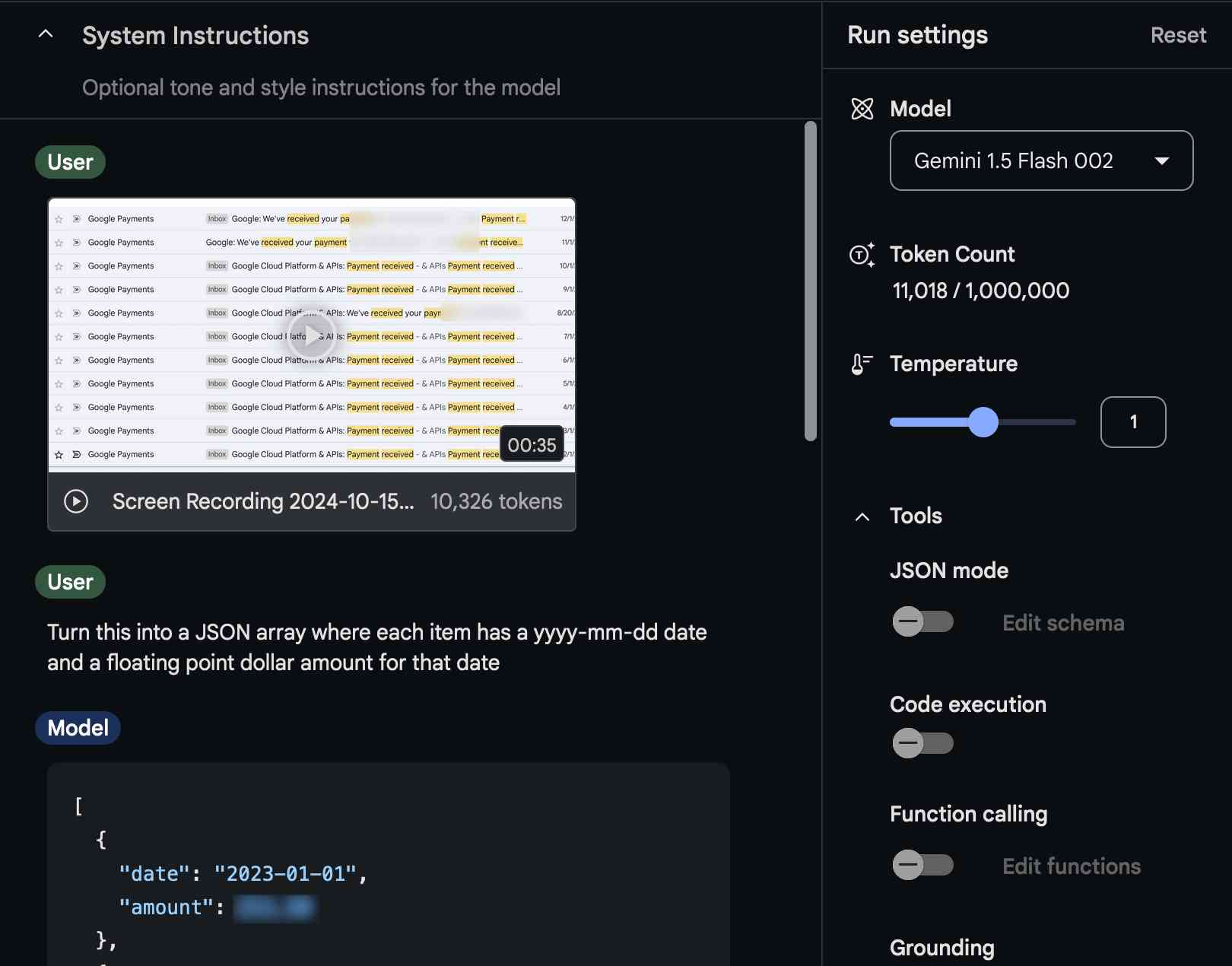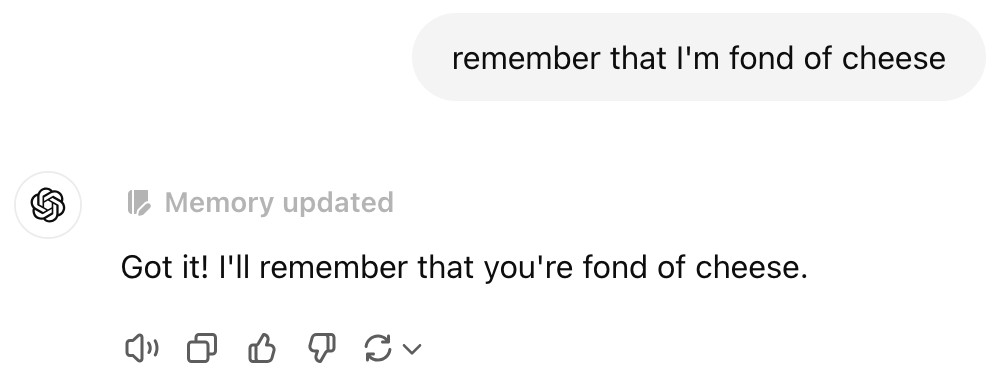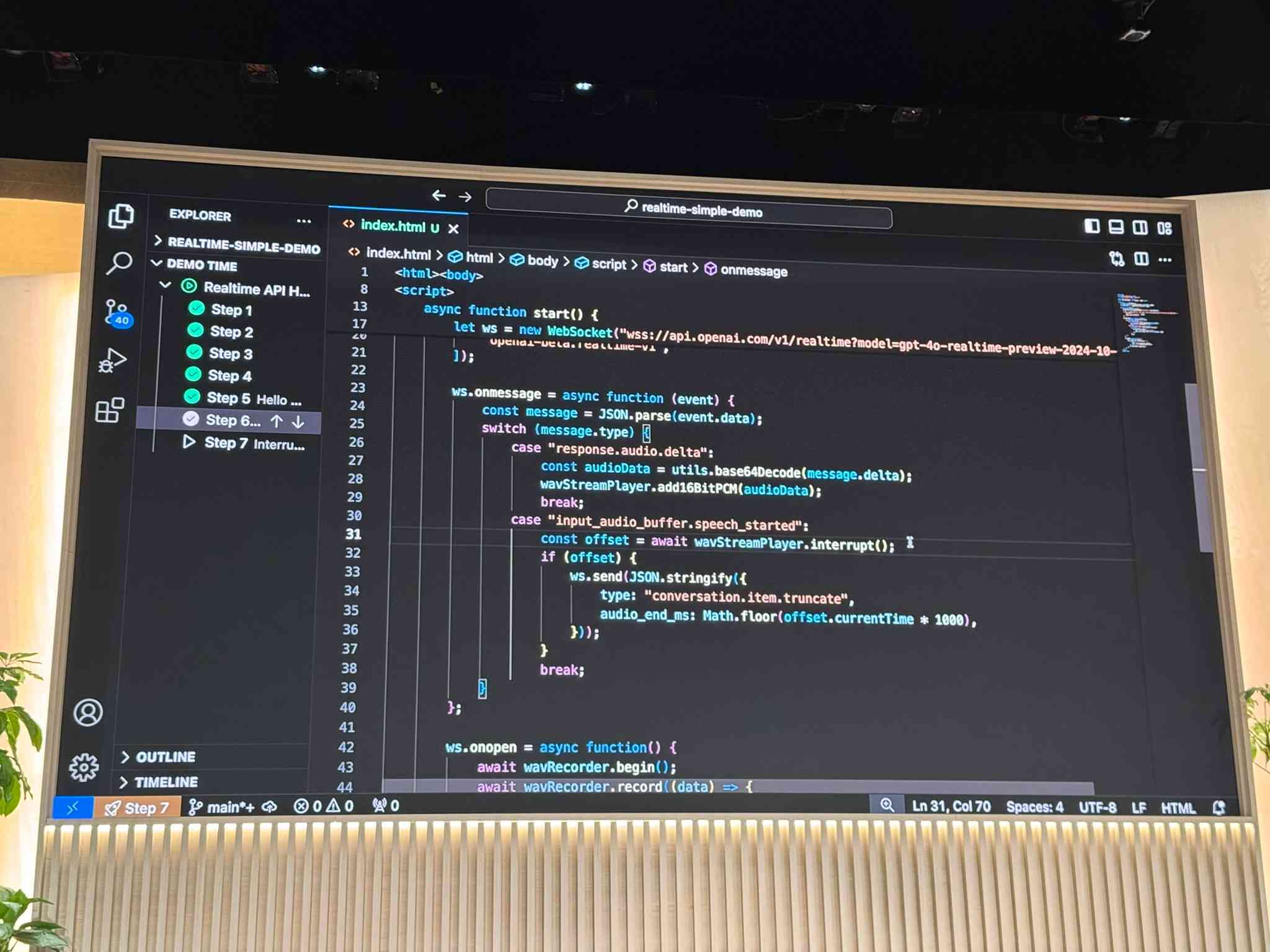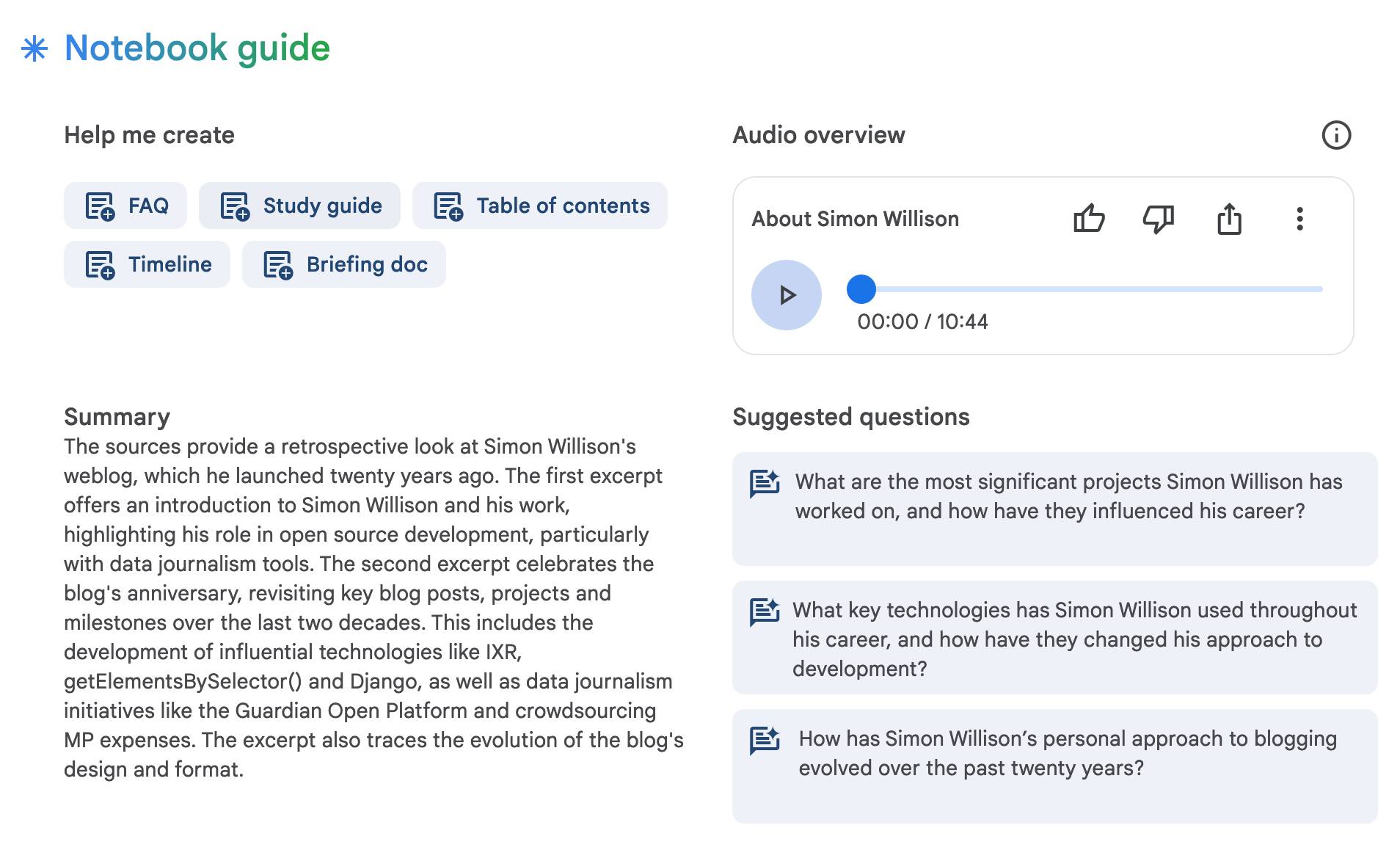1,548 posts tagged “generative-ai”
Machine learning systems that can generate new content: text, images, audio, video and more.
2024
New in NotebookLM: Customizing your Audio Overviews. The most requested feature for Google's NotebookLM "audio overviews" (aka automatically generated podcast conversations) has been the ability to provide direction to those artificial podcast hosts - setting their expertise level or asking them to focus on specific topics.
Today's update adds exactly that:
Now you can provide instructions before you generate a "Deep Dive" Audio Overview. For example, you can focus on specific topics or adjust the expertise level to suit your audience. Think of it like slipping the AI hosts a quick note right before they go on the air, which will change how they cover your material.
I pasted in a link to my post about video scraping and prompted it like this:
You are both pelicans who work as data journalist at a pelican news service. Discuss this from the perspective of pelican data journalists, being sure to inject as many pelican related anecdotes as possible
Here's the resulting 7m40s MP3, and the transcript.
It starts off strong!
You ever find yourself wading through mountains of data trying to pluck out the juicy bits? It's like hunting for a single shrimp in a whole kelp forest, am I right?
Then later:
Think of those facial recognition systems they have for humans. We could have something similar for our finned friends. Although, gotta say, the ethical implications of that kind of tech are a whole other kettle of fish. We pelicans gotta use these tools responsibly and be transparent about it.
And when brainstorming some potential use-cases:
Imagine a pelican citizen journalist being able to analyze footage of a local council meeting, you know, really hold those pelicans in power accountable, or a pelican historian using video scraping to analyze old film reels, uncovering lost details about our pelican ancestors.
Plus this delightful conclusion:
The future of data journalism is looking brighter than a school of silversides reflecting the morning sun. Until next time, keep those wings spread, those eyes sharp, and those minds open. There's a whole ocean of data out there just waiting to be explored.
And yes, people on Reddit have got them to swear.
Video scraping: extracting JSON data from a 35 second screen capture for less than 1/10th of a cent
The other day I found myself needing to add up some numeric values that were scattered across twelve different emails.
[... 1,294 words]Gemini API Additional Terms of Service. I've been trying to figure out what Google's policy is on using data submitted to their Google Gemini LLM for further training. It turns out it's clearly spelled out in their terms of service, but it differs for the paid v.s. free tiers.
The paid APIs do not train on your inputs:
When you're using Paid Services, Google doesn't use your prompts (including associated system instructions, cached content, and files such as images, videos, or documents) or responses to improve our products [...] This data may be stored transiently or cached in any country in which Google or its agents maintain facilities.
The Gemini API free tier does:
The terms in this section apply solely to your use of Unpaid Services. [...] Google uses this data, consistent with our Privacy Policy, to provide, improve, and develop Google products and services and machine learning technologies, including Google’s enterprise features, products, and services. To help with quality and improve our products, human reviewers may read, annotate, and process your API input and output.
But watch out! It looks like the AI Studio tool, since it's offered for free (even if you have a paid account setup) is treated as "free" for the purposes of these terms. There's also an interesting note about the EU:
The terms in this "Paid Services" section apply solely to your use of paid Services ("Paid Services"), as opposed to any Services that are offered free of charge like direct interactions with Google AI Studio or unpaid quota in Gemini API ("Unpaid Services"). [...] If you're in the European Economic Area, Switzerland, or the United Kingdom, the terms applicable to Paid Services apply to all Services including AI Studio even though it's offered free of charge.
Confusingly, the following paragraph about data used to fine-tune your own custom models appears in that same "Data Use for Unpaid Services" section:
Google only uses content that you import or upload to our model tuning feature for that express purpose. Tuning content may be retained in connection with your tuned models for purposes of re-tuning when supported models change. When you delete a tuned model, the related tuning content is also deleted.
It turns out their tuning service is "free of charge" on both pay-as-you-go and free plans according to the Gemini pricing page, though you still pay for input/output tokens at inference time (on the paid tier - it looks like the free tier remains free even for those fine-tuned models).
Un Ministral, des Ministraux (via) Two new models from Mistral: Ministral 3B and Ministral 8B - joining Mixtral, Pixtral, Codestral and Mathstral as weird naming variants on the Mistral theme.
These models set a new frontier in knowledge, commonsense, reasoning, function-calling, and efficiency in the sub-10B category, and can be used or tuned to a variety of uses, from orchestrating agentic workflows to creating specialist task workers. Both models support up to 128k context length (currently 32k on vLLM) and Ministral 8B has a special interleaved sliding-window attention pattern for faster and memory-efficient inference.
Mistral's own benchmarks look impressive, but it's hard to get excited about small on-device models with a non-commercial Mistral Research License (for the 8B) and a contact-us-for-pricing Mistral Commercial License (for the 8B and 3B), given the existence of the extremely high quality Llama 3.1 and 3.2 series of models.
These new models are also available through Mistral's la Plateforme API, priced at $0.1/million tokens (input and output) for the 8B and $0.04/million tokens for the 3B.
The latest release of my llm-mistral plugin for LLM adds aliases for the new models. Previously you could access them like this:
llm mistral refresh # To fetch new models
llm -m mistral/ministral-3b-latest "a poem about pelicans at the park"
llm -m mistral/ministral-8b-latest "a poem about a pelican in french"
With the latest plugin version you can do this:
llm install -U llm-mistral
llm -m ministral-8b "a poem about a pelican in french"
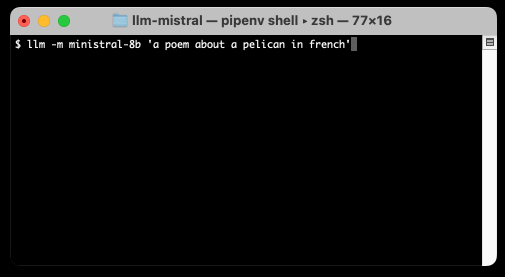
A common misconception about Transformers is to believe that they're a sequence-processing architecture. They're not.
They're a set-processing architecture. Transformers are 100% order-agnostic (which was the big innovation compared to RNNs, back in late 2016 -- you compute the full matrix of pairwise token interactions instead of processing one token at a time).
The way you add order awareness in a Transformer is at the feature level. You literally add to your token embeddings a position embedding / encoding that corresponds to its place in a sequence. The architecture itself just treats the input tokens as a set.
ChatGPT will happily write you a thinly disguised horoscope
There’s a meme floating around at the moment where you ask ChatGPT the following and it appears to offer deep insight into your personality:
[... 1,236 words]My Jina Reader tool. I wanted to feed the Cloudflare Durable Objects SQLite documentation into Claude, but I was on my iPhone so copying and pasting was inconvenient. Jina offer a Reader API which can turn any URL into LLM-friendly Markdown and it turns out it supports CORS, so I got Claude to build me this tool (second iteration, third iteration, final source code).
Paste in a URL to get the Jina Markdown version, along with an all important "Copy to clipboard" button.
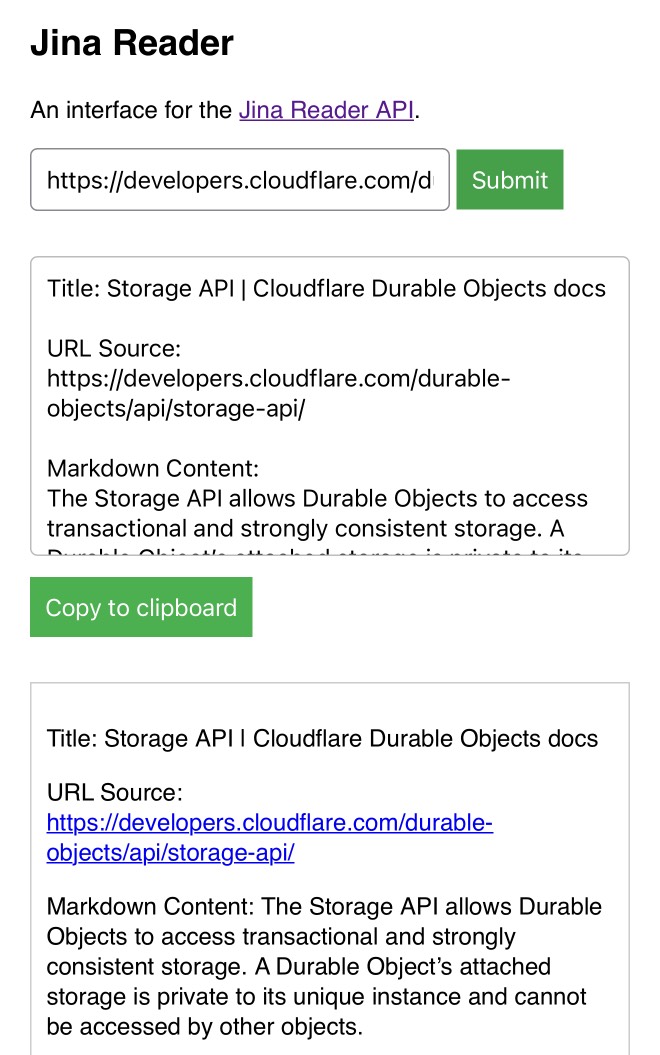
An LLM TDD loop (via) Super neat demo by David Winterbottom, who wrapped my LLM and files-to-prompt tools in a short Bash script that can be fed a file full of Python unit tests and an empty implementation file and will then iterate on that file in a loop until the tests pass.
lm.rs: run inference on Language Models locally on the CPU with Rust (via) Impressive new LLM inference implementation in Rust by Samuel Vitorino. I tried it just now on an M2 Mac with 64GB of RAM and got very snappy performance for this Q8 Llama 3.2 1B, with Activity Monitor reporting 980% CPU usage over 13 threads.
Here's how I compiled the library and ran the model:
cd /tmp
git clone https://github.com/samuel-vitorino/lm.rs
cd lm.rs
RUSTFLAGS="-C target-cpu=native" cargo build --release --bin chat
curl -LO 'https://huggingface.co/samuel-vitorino/Llama-3.2-1B-Instruct-Q8_0-LMRS/resolve/main/tokenizer.bin?download=true'
curl -LO 'https://huggingface.co/samuel-vitorino/Llama-3.2-1B-Instruct-Q8_0-LMRS/resolve/main/llama3.2-1b-it-q80.lmrs?download=true'
./target/release/chat --model llama3.2-1b-it-q80.lmrs --show-metrics
That --show-metrics option added this at the end of a response:
Speed: 26.41 tok/s
It looks like the performance is helped by two key dependencies: wide, which provides data types optimized for SIMD operations and rayon for running parallel iterators across multiple cores (used for matrix multiplication).
(I used LLM and files-to-prompt to help figure this out.)
RISD BFA Industrial Design: AI Software Design Studio. Fascinating syllabus for a course on digital product design taught at the Rhode Island School of Design by Kelin Carolyn Zhang.
Designers must adapt and shape the frontier of AI-driven computing — while navigating the opportunities, risks, and ethical responsibilities of working with this new technology.
In this new world, creation is cheap, craft is automatable, and everyone is a beginner. The ultimate differentiator will be the creator’s perspective, taste, and judgment. The software design education for our current moment must prioritize this above all else.
By course's end, students will have hands-on experience with an end-to-end digital product design process, culminating in a physical or digital product that takes advantage of the unique properties of generative AI models. Prior coding experience is not required, but students will learn using AI coding assistants like ChatGPT and Claude.
From Kelin's Twitter thread about the course so far:
these are juniors in industrial design. about half of them don't have past experience even designing software or using figma [...]
to me, they're doing great because they're moving super quickly
what my 4th yr interaction design students in 2019 could make in half a semester, these 3rd year industrial design students are doing in a few days with no past experience [...]
they very quickly realized the limits of LLM code in week 1, especially in styling & creating unconventional behavior
AI can help them make a functional prototype with js in minutes, but it doesn't look good
openai/openai-realtime-console. I got this OpenAI demo repository working today - it's an extremely easy way to get started playing around with the new Realtime voice API they announced at DevDay last week:
cd /tmp
git clone https://github.com/openai/openai-realtime-console
cd openai-realtime-console
npm i
npm start
That starts a localhost:3000 server running the demo React application. It asks for an API key, you paste one in and you can start talking to the web page.
The demo handles voice input, voice output and basic tool support - it has a tool that can show you the weather anywhere in the world, including panning a map to that location. I tried adding a show_map() tool so I could pan to a location just by saying "Show me a map of the capital of Morocco" - all it took was editing the src/pages/ConsolePage.tsx file and hitting save, then refreshing the page in my browser to pick up the new function.
Be warned, it can be quite expensive to play around with. I was testing the application intermittently for only about 15 minutes and racked up $3.87 in API charges.
Anthropic: Message Batches (beta) (via) Anthropic now have a batch mode, allowing you to send prompts to Claude in batches which will be processed within 24 hours (though probably much faster than that) and come at a 50% price discount.
This matches the batch models offered by OpenAI and by Google Gemini, both of which also provide a 50% discount.
Update 15th October 2024: Alex Albert confirms that Anthropic batching and prompt caching can be combined:
Don't know if folks have realized yet that you can get close to a 95% discount on Claude 3.5 Sonnet tokens when you combine prompt caching with the new Batches API
SVG to JPG/PNG. The latest in my ongoing series of interactive HTML and JavaScript tools written almost entirely by LLMs. This one lets you paste in (or open-from-file, or drag-onto-page) some SVG and then use that to render a JPEG or PNG image of your desired width.
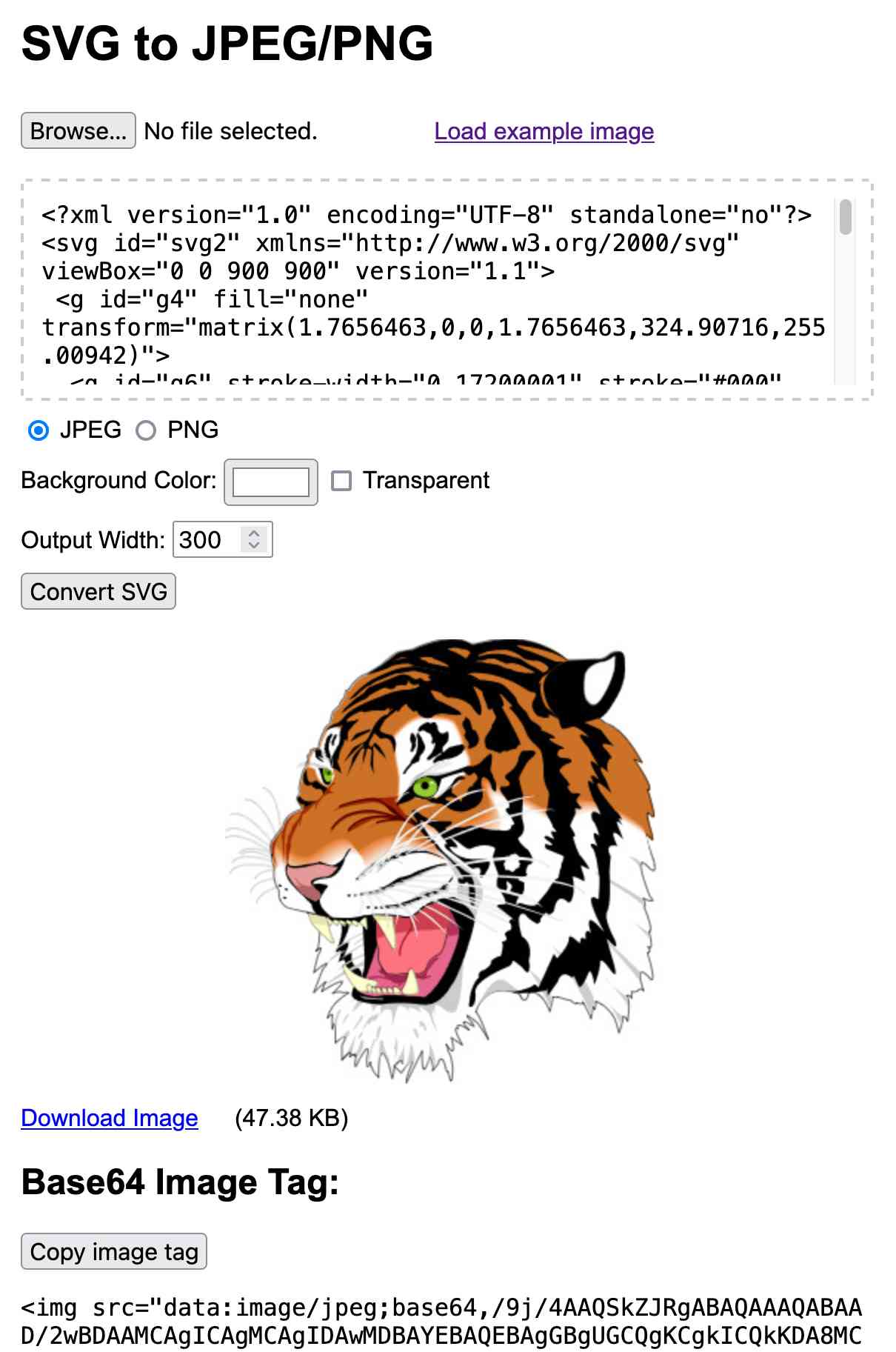
I built this using Claude 3.5 Sonnet, initially as an Artifact and later in a code editor since some of the features (loading an example image and downloading the result) cannot run in the sandboxed iframe Artifact environment.
Here's the full transcript of the Claude conversation I used to build the tool, plus a few commits I later made by hand to further customize it.
The code itself is mostly quite simple. The most interesting part is how it renders the SVG to an image, which (simplified) looks like this:
// First extract the viewbox to get width/height
const svgElement = new DOMParser().parseFromString(
svgInput, 'image/svg+xml'
).documentElement;
let viewBox = svgElement.getAttribute('viewBox');
[, , width, height] = viewBox.split(' ').map(Number);
// Figure out the width/height of the output image
const newWidth = parseInt(widthInput.value) || 800;
const aspectRatio = width / height;
const newHeight = Math.round(newWidth / aspectRatio);
// Create off-screen canvas
const canvas = document.createElement('canvas');
canvas.width = newWidth;
canvas.height = newHeight;
// Draw SVG on canvas
const svgBlob = new Blob([svgInput], {type: 'image/svg+xml;charset=utf-8'});
const svgUrl = URL.createObjectURL(svgBlob);
const img = new Image();
const ctx = canvas.getContext('2d');
img.onload = function() {
ctx.drawImage(img, 0, 0, newWidth, newHeight);
URL.revokeObjectURL(svgUrl);
// Convert that to a JPEG
const imageDataUrl = canvas.toDataURL("image/jpeg");
const convertedImg = document.createElement('img');
convertedImg.src = imageDataUrl;
imageContainer.appendChild(convertedImg);
};
img.src = svgUrl;Here's the MDN explanation of that revokeObjectURL() method, which I hadn't seen before.
Call this method when you've finished using an object URL to let the browser know not to keep the reference to the file any longer.
marimo v0.9.0 with mo.ui.chat. The latest release of the Marimo Python reactive notebook project includes a neat new feature: you can now easily embed a custom chat interface directly inside of your notebook.
Marimo co-founder Myles Scolnick posted this intriguing demo on Twitter, demonstrating a chat interface to my LLM library “in only 3 lines of code”:
import marimo as mo import llm model = llm.get_model() conversation = model.conversation() mo.ui.chat(lambda messages: conversation.prompt(messages[-1].content))
I tried that out today - here’s the result:
![Screenshot of a Marimo notebook editor, with lines of code and an embedded chat interface. Top: import marimo as mo and import llm. Middle: Chat messages - User: Hi there, Three jokes about pelicans. AI: Hello! How can I assist you today?, Sure! Here are three pelican jokes for you: 1. Why do pelicans always carry a suitcase? Because they have a lot of baggage to handle! 2. What do you call a pelican that can sing? A tune-ican! 3. Why did the pelican break up with his girlfriend? She said he always had his head in the clouds and never winged it! Hope these made you smile! Bottom code: model = llm.get_model(), conversation = model.conversation(), mo.ui.chat(lambda messages:, conversation.prompt(messages[-1].content))](https://static.simonwillison.net/static/2024/marimo-pelican-jokes.jpg)
marimo.ui.chat() takes a function which is passed a list of Marimo chat messages (representing the current state of that widget) and returns a string - or other type of renderable object - to add as the next message in the chat. This makes it trivial to hook in any custom chat mechanism you like.
Marimo also ship their own built-in chat handlers for OpenAI, Anthropic and Google Gemini which you can use like this:
mo.ui.chat( mo.ai.llm.anthropic( "claude-3-5-sonnet-20240620", system_message="You are a helpful assistant.", api_key="sk-ant-...", ), show_configuration_controls=True )
Gemini 1.5 Flash-8B is now production ready (via) Gemini 1.5 Flash-8B is "a smaller and faster variant of 1.5 Flash" - and is now released to production, at half the price of the 1.5 Flash model.
It's really, really cheap:
- $0.0375 per 1 million input tokens on prompts <128K
- $0.15 per 1 million output tokens on prompts <128K
- $0.01 per 1 million input tokens on cached prompts <128K
Prices are doubled for prompts longer than 128K.
I believe images are still charged at a flat rate of 258 tokens, which I think means a single non-cached image with Flash should cost 0.00097 cents - a number so tiny I'm doubting if I got the calculation right.
OpenAI's cheapest model remains GPT-4o mini, at $0.15/1M input - though that drops to half of that for reused prompt prefixes thanks to their new prompt caching feature (or by half if you use batches, though those can’t be combined with OpenAI prompt caching. Gemini also offer half-off for batched requests).
Anthropic's cheapest model is still Claude 3 Haiku at $0.25/M, though that drops to $0.03/M for cached tokens (if you configure them correctly).
I've released llm-gemini 0.2 with support for the new model:
llm install -U llm-gemini
llm keys set gemini
# Paste API key here
llm -m gemini-1.5-flash-8b-latest "say hi"
At first, I struggled to understand why anyone would want to write this way. My dialogue with ChatGPT was frustratingly meandering, as though I were excavating an essay instead of crafting one. But, when I thought about the psychological experience of writing, I began to see the value of the tool. ChatGPT was not generating professional prose all at once, but it was providing starting points: interesting research ideas to explore; mediocre paragraphs that might, with sufficient editing, become usable. For all its inefficiencies, this indirect approach did feel easier than staring at a blank page; “talking” to the chatbot about the article was more fun than toiling in quiet isolation. In the long run, I wasn’t saving time: I still needed to look up facts and write sentences in my own voice. But my exchanges seemed to reduce the maximum mental effort demanded of me.
Announcing FLUX1.1 [pro] and the BFL API (via) FLUX is the image generation model family from Black Forest Labs, a startup founded by members of the team that previously created Stable Diffusion.
Released today, FLUX1.1 [pro] continues the general trend of AI models getting both better and more efficient:
FLUX1.1 [pro] provides six times faster generation than its predecessor FLUX.1 [pro] while also improving image quality, prompt adherence, and diversity.
Black Forest Labs appear to have settled on a potentially workable business model: their smallest, fastest model FLUX.1 [schnell] is Apache 2 licensed. The next step up is FLUX.1 [dev] which is open weights for non-commercial use only. The [pro] models are closed weights, made available exclusively through their API or partnerships with other API providers.
I tried the new 1.1 model out using black-forest-labs/flux-1.1-pro on Replicate just now. Here's my prompt:
Photograph of a Faberge egg representing the California coast. It should be decorated with ornate pelicans and sea lions and a humpback whale.

The FLUX models have a reputation for being really good at following complex prompts. In this case I wanted the sea lions to appear in the egg design rather than looking at the egg from the beach, but I imagine I could get better results if I continued to iterate on my prompt.
The FLUX models are also better at applying text than any other image models I've tried myself.
OpenAI DevDay: Let’s build developer tools, not digital God
I had a fun time live blogging OpenAI DevDay yesterday—I’ve now shared notes about the live blogging system I threw other in a hurry on the day (with assistance from Claude and GPT-4o). Now that the smoke has settled a little, here are my impressions from the event.
[... 2,090 words]Building an automatically updating live blog in Django. Here's an extended write-up of how I implemented the live blog feature I used for my coverage of OpenAI DevDay yesterday. I built the first version using Claude while waiting for the keynote to start, then upgraded it during the lunch break with the help of GPT-4o to add sort options and incremental fetching of new updates.
OpenAI DevDay 2024 live blog
I’m at OpenAI DevDay in San Francisco, and I’m trying something new: a live blog, where this entry will be updated with new notes during the event.
[... 68 words]I listened to the whole 15-minute podcast this morning. It was, indeed, surprisingly effective. It remains somewhere in the uncanny valley, but not at all in a creepy way. Just more in a “this is a bit vapid and phony” way. [...] But ultimately the conversation has all the flavor of a bowl of unseasoned white rice.
llama-3.2-webgpu (via) Llama 3.2 1B is a really interesting models, given its 128,000 token input and its tiny size (barely more than a GB).
This page loads a 1.24GB q4f16 ONNX build of the Llama-3.2-1B-Instruct model and runs it with a React-powered chat interface directly in the browser, using Transformers.js and WebGPU. Source code for the demo is here.
It worked for me just now in Chrome; in Firefox and Safari I got a “WebGPU is not supported by this browser” error message.
NotebookLM’s automatically generated podcasts are surprisingly effective
Audio Overview is a fun new feature of Google’s NotebookLM which is getting a lot of attention right now. It generates a one-off custom podcast against content you provide, where two AI hosts start up a “deep dive” discussion about the collected content. These last around ten minutes and are very podcast, with an astonishingly convincing audio back-and-forth conversation.
[... 1,489 words]mlx-vlm (via) The MLX ecosystem of libraries for running machine learning models on Apple Silicon continues to expand. Prince Canuma is actively developing this library for running vision models such as Qwen-2 VL and Pixtral and LLaVA using Python running on a Mac.
I used uv to run it against this image with this shell one-liner:
uv run --with mlx-vlm \
python -m mlx_vlm.generate \
--model Qwen/Qwen2-VL-2B-Instruct \
--max-tokens 1000 \
--temp 0.0 \
--image https://static.simonwillison.net/static/2024/django-roadmap.png \
--prompt "Describe image in detail, include all text"
The --image option works equally well with a URL or a path to a local file on disk.
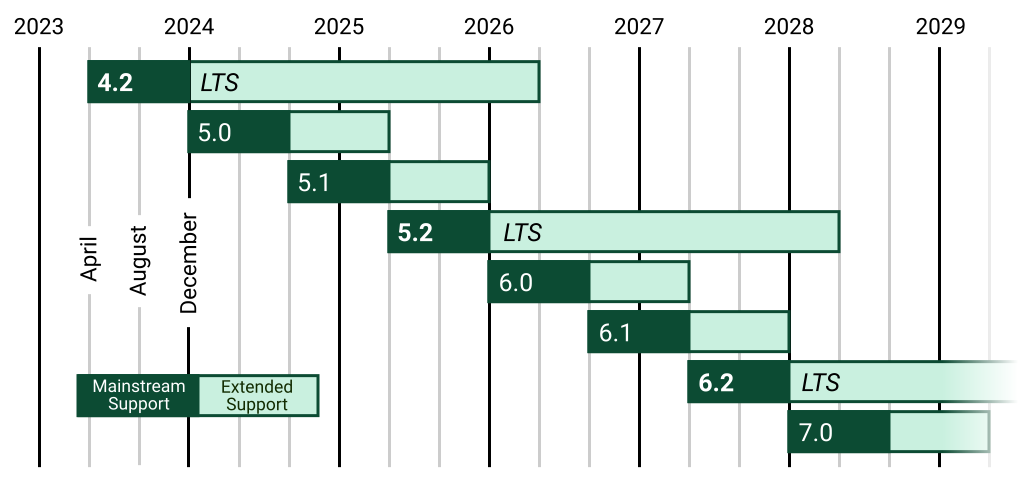
This first downloaded 4.1GB to my ~/.cache/huggingface/hub/models--Qwen--Qwen2-VL-2B-Instruct folder and then output this result, which starts:
The image is a horizontal timeline chart that represents the release dates of various software versions. The timeline is divided into years from 2023 to 2029, with each year represented by a vertical line. The chart includes a legend at the bottom, which distinguishes between different types of software versions.
Legend
Mainstream Support:
- 4.2 (2023)
- 5.0 (2024)
- 5.1 (2025)
- 5.2 (2026)
- 6.0 (2027) [...]
In the future, we won't need programmers; just people who can describe to a computer precisely what they want it to do.
I think individual creators or publishers tend to overestimate the value of their specific content in the grand scheme of [AI training]. […]
We pay for content when it’s valuable to people. We’re just not going to pay for content when it’s not valuable to people. I think that you’ll probably see a similar dynamic with AI, which my guess is that there are going to be certain partnerships that get made when content is really important and valuable. I’d guess that there are probably a lot of people who have a concern about the feel of it, like you’re saying. But then, when push comes to shove, if they demanded that we don’t use their content, then we just wouldn’t use their content. It’s not like that’s going to change the outcome of this stuff that much.
Llama 3.2. In further evidence that AI labs are terrible at naming things, Llama 3.2 is a huge upgrade to the Llama 3 series - they've released their first multi-modal vision models!
Today, we’re releasing Llama 3.2, which includes small and medium-sized vision LLMs (11B and 90B), and lightweight, text-only models (1B and 3B) that fit onto edge and mobile devices, including pre-trained and instruction-tuned versions.
The 1B and 3B text-only models are exciting too, with a 128,000 token context length and optimized for edge devices (Qualcomm and MediaTek hardware get called out specifically).
Meta partnered directly with Ollama to help with distribution, here's the Ollama blog post. They only support the two smaller text-only models at the moment - this command will get the 3B model (2GB):
ollama run llama3.2
And for the 1B model (a 1.3GB download):
ollama run llama3.2:1b
I had to first upgrade my Ollama by clicking on the icon in my macOS task tray and selecting "Restart to update".
The two vision models are coming to Ollama "very soon".
Once you have fetched the Ollama model you can access it from my LLM command-line tool like this:
pipx install llm
llm install llm-ollama
llm chat -m llama3.2:1b
I tried running my djp codebase through that tiny 1B model just now and got a surprisingly good result - by no means comprehensive, but way better than I would ever expect from a model of that size:
files-to-prompt **/*.py -c | llm -m llama3.2:1b --system 'describe this code'
Here's a portion of the output:
The first section defines several test functions using the
@djp.hookimpldecorator from the djp library. These hook implementations allow you to intercept and manipulate Django's behavior.
test_middleware_order: This function checks that the middleware order is correct by comparing theMIDDLEWAREsetting with a predefined list.test_middleware: This function tests various aspects of middleware:- It retrieves the response from the URL
/from-plugin/using theClientobject, which simulates a request to this view.- It checks that certain values are present in the response:
X-DJP-Middleware-AfterX-DJP-MiddlewareX-DJP-Middleware-Before[...]
I found the GGUF file that had been downloaded by Ollama in my ~/.ollama/models/blobs directory. The following command let me run that model directly in LLM using the llm-gguf plugin:
llm install llm-gguf
llm gguf register-model ~/.ollama/models/blobs/sha256-74701a8c35f6c8d9a4b91f3f3497643001d63e0c7a84e085bed452548fa88d45 -a llama321b
llm chat -m llama321b
Meta themselves claim impressive performance against other existing models:
Our evaluation suggests that the Llama 3.2 vision models are competitive with leading foundation models, Claude 3 Haiku and GPT4o-mini on image recognition and a range of visual understanding tasks. The 3B model outperforms the Gemma 2 2.6B and Phi 3.5-mini models on tasks such as following instructions, summarization, prompt rewriting, and tool-use, while the 1B is competitive with Gemma.
Here's the Llama 3.2 collection on Hugging Face. You need to accept the new Llama 3.2 Community License Agreement there in order to download those models.
You can try the four new models out via the Chatbot Arena - navigate to "Direct Chat" there and select them from the dropdown menu. You can upload images directly to the chat there to try out the vision features.
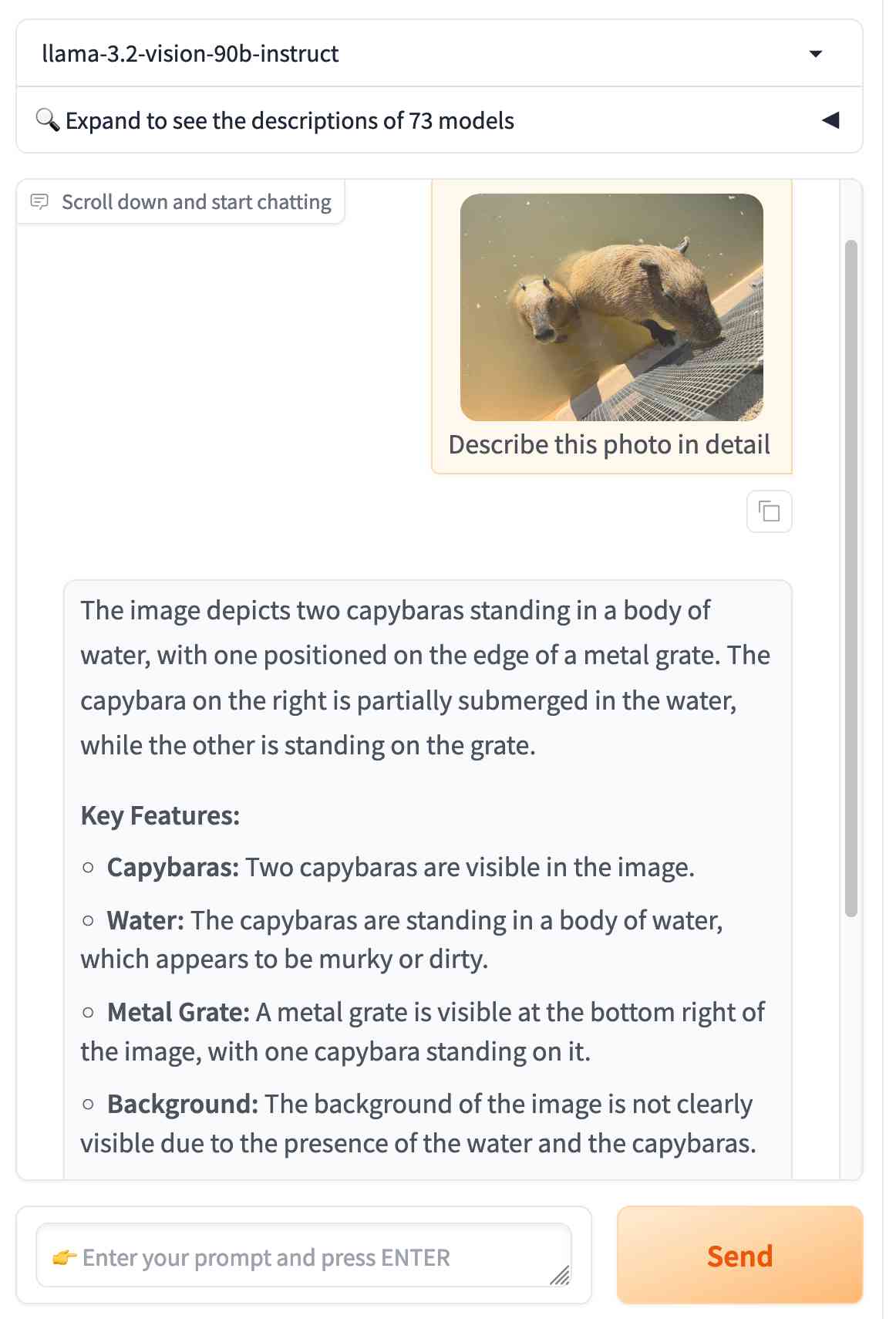
Solving a bug with o1-preview, files-to-prompt and LLM.
I added a new feature to DJP this morning: you can now have plugins specify their middleware in terms of how it should be positioned relative to other middleware - inserted directly before or directly after django.middleware.common.CommonMiddleware for example.
At one point I got stuck with a weird test failure, and after ten minutes of head scratching I decided to pipe the entire thing into OpenAI's o1-preview to see if it could spot the problem. I used files-to-prompt to gather the code and LLM to run the prompt:
files-to-prompt **/*.py -c | llm -m o1-preview "
The middleware test is failing showing all of these - why is MiddlewareAfter repeated so many times?
['MiddlewareAfter', 'Middleware3', 'MiddlewareAfter', 'Middleware5', 'MiddlewareAfter', 'Middleware3', 'MiddlewareAfter', 'Middleware2', 'MiddlewareAfter', 'Middleware3', 'MiddlewareAfter', 'Middleware5', 'MiddlewareAfter', 'Middleware3', 'MiddlewareAfter', 'Middleware4', 'MiddlewareAfter', 'Middleware3', 'MiddlewareAfter', 'Middleware5', 'MiddlewareAfter', 'Middleware3', 'MiddlewareAfter', 'Middleware2', 'MiddlewareAfter', 'Middleware3', 'MiddlewareAfter', 'Middleware5', 'MiddlewareAfter', 'Middleware3', 'MiddlewareAfter', 'Middleware', 'MiddlewareBefore']"The model whirled away for a few seconds and spat out an explanation of the problem - one of my middleware classes was accidentally calling self.get_response(request) in two different places.
I did enjoy how o1 attempted to reference the relevant Django documentation and then half-repeated, half-hallucinated a quote from it:
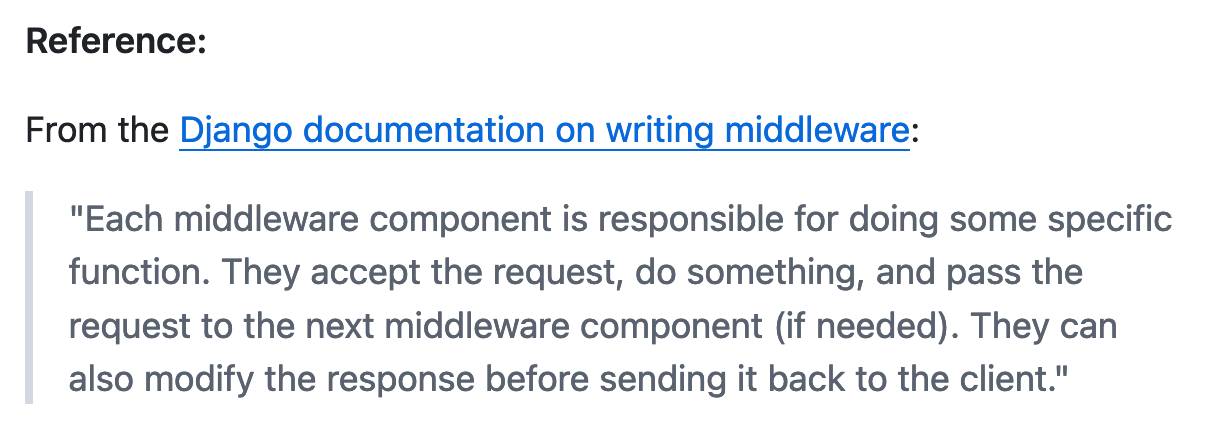
This took 2,538 input tokens and 4,354 output tokens - by my calculations at $15/million input and $60/million output that prompt cost just under 30 cents.
The Pragmatic Engineer Podcast: AI tools for software engineers, but without the hype – with Simon Willison. Gergely Orosz has a brand new podcast, and I was the guest for the first episode. We covered a bunch of ground, but my favorite topic was an exploration of the (very legitimate) reasons that many engineers are resistant to taking advantage of AI-assisted programming tools.
Updated production-ready Gemini models.
Two new models from Google Gemini today: gemini-1.5-pro-002 and gemini-1.5-flash-002. Their -latest aliases will update to these new models in "the next few days", and new -001 suffixes can be used to stick with the older models. The new models benchmark slightly better in various ways and should respond faster.
Flash continues to have a 1,048,576 input token and 8,192 output token limit. Pro is 2,097,152 input tokens.
Google also announced a significant price reduction for Pro, effective on the 1st of October. Inputs less than 128,000 tokens drop from $3.50/million to $1.25/million (above 128,000 tokens it's dropping from $7 to $5) and output costs drop from $10.50/million to $2.50/million ($21 down to $10 for the >128,000 case).
For comparison, GPT-4o is currently $5/m input and $15/m output and Claude 3.5 Sonnet is $3/m input and $15/m output. Gemini 1.5 Pro was already the cheapest of the frontier models and now it's even cheaper.
Correction: I missed gpt-4o-2024-08-06 which is listed later on the OpenAI pricing page and priced at $2.50/m input and $10/m output. So the new Gemini 1.5 Pro prices are undercutting that.
Gemini has always offered finely grained safety filters - it sounds like those are now turned down to minimum by default, which is a welcome change:
For the models released today, the filters will not be applied by default so that developers can determine the configuration best suited for their use case.
Also interesting: they've tweaked the expected length of default responses:
For use cases like summarization, question answering, and extraction, the default output length of the updated models is ~5-20% shorter than previous models.
